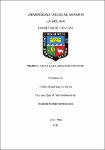Mostrar el registro sencillo del ítem
Olas de calor en la Amazonía peruana
| dc.contributor.advisor | Calle Montes, Victoria Doris | |
| dc.contributor.advisor | Quispe Gutiérrez, Nelson | |
| dc.contributor.author | Castillo Gálvez, Fidel Cristóbal | |
| dc.date.accessioned | 2018-06-19T16:57:24Z | |
| dc.date.available | 2018-06-19T16:57:24Z | |
| dc.date.issued | 2018 | |
| dc.identifier.other | P40.C378-T BAN UNALM | |
| dc.identifier.uri | https://hdl.handle.net/20.500.12996/3392 | |
| dc.description | Universidad Nacional Agraria La Molina. Facultad de Ciencias. Departamento Académico de Ingeniería Ambiental, Física y Meteorología | es_PE |
| dc.description.abstract | En el presente trabajo se identificó y caracterizo los eventos de calor de la región Amazónica Peruana en los meses de setiembre, octubre y noviembre desde 1895 a 2015. Se usó la técnica de percentiles estadísticos, se evaluó la OC mediante los efectos fisiológicos registrados por el MINSA en los periodos 2013 y 2015, se realizó la caracterización de las variables meteorológicas (t max, tmin), análisis de los mecanismos físicos asociados a la OC, determinación de entorno sinóptico, desarrollo del modelo conceptual. Se encontró que las OC se inician con el APSO alejado del continente , presencia de jet de bajos niveles LLJ nocturno cerca a Bolivia, anomalías positivas de Radiación de onda larga (OLR) y anomalías negativas de precipitación (Pp) en la Amazonía peruana contribuyendo al calentamiento superficial y cielos despejados durante el día, en el horario nocturno se aprecia convección llana y expansión de la capa troposférica originando complejos convectivos a mesoescala (CCM) a niveles bajos y medios e impidiendo la disminución de la temperatura. También a niveles altos presenta un anticiclón y una dorsal continental en la parte sur de Perú la cual favorece la subsidencia hasta los niveles medios de la tropósfera. Al finalizar una OC se muestra el ingreso de una Alta Migratoria (AM) que se desplaza por el continente llegando a ubicarse en el océano atlántico, por otra parte en alta tropósfera se presenta la formación de un sistema cuña vaguada, una circulación ciclónica proveniente del noreste de Brasil y en los niveles medios una banda de humedad relativa superior al 70% proveniente del sureste del continente y formación de Sistemas Convectivas a Mesoescala (SCM) de gran desarrollo generando Precipitación enfriando el entorno., debido a esta interacción en los diferentes niveles dan resultados que indican un cambio brusco de la temperatura. | es_PE |
| dc.description.abstract | In the present work, the heat events of the Peruvian Amazon region were identified and characterized in the months of September, October and November from 1895 to 2015. The statistical percentile technique was used, the OC was evaluated by the physiological effects registered by the MINSA in the periods 2013 and 2015, the characterization of the meteorological variables (t max, tmin), analysis of the physical mechanisms associated with the OC, determination of the synoptic environment, development of the conceptual model. It was found that OCs start with the APSO away from the mainland, presence of low LLJ jet levels near Bolivia, positive long wave radiation (OLR) anomalies and negative precipitation anomalies (Pp) in the Peruvian Amazon contributing to the Surface heating and clear skies during the day, at night time flat convection and tropospheric layer expansion are observed causing mesoscale convective complexes (MCC) at low and medium levels and preventing the temperature decrease. Also at high levels it has an anticyclone and a continental ridge in the southern part of Peru which favors subsidence to the middle levels of the troposphere. At the end of an OC the entry of a High Migratory (AM) that moves around the continent arriving to be located in the Atlantic Ocean is shown, on the other hand in high troposphere the formation of a wedge-shaped system is shown, a cyclonic circulation coming from the northeast of Brazil and in the middle levels a band of relative humidity greater than 70% coming from the southeast of the continent and formation of Convective Systems to Mesoscale (SCM) of great development generating Precipitation cooling the environment., due to this interaction in the different levels give results that indicate a sudden change in temperature. | en_US |
| dc.format | application/pdf | en_US |
| dc.language.iso | spa | es_PE |
| dc.publisher | Universidad Nacional Agraria La Molina | es_PE |
| dc.rights | info:eu-repo/semantics/openAccess | en_US |
| dc.rights.uri | https://creativecommons.org/licenses/by-nc-nd/4.0/ | * |
| dc.subject | Calor | es_PE |
| dc.subject | Amazonía | es_PE |
| dc.subject | Estación cálida | es_PE |
| dc.subject | Masas de aire | es_PE |
| dc.subject | Medición | es_PE |
| dc.subject | Frente de calor | es_PE |
| dc.subject | Pronóstico del tiempo | es_PE |
| dc.subject | Evaluación | es_PE |
| dc.subject | Perú | es_PE |
| dc.subject | Ola de calor | es_PE |
| dc.title | Olas de calor en la Amazonía peruana | es_PE |
| dc.type | info:eu-repo/semantics/bachelorThesis | en_US |
| thesis.degree.discipline | Ingeniería Ambiental, Física y Meteorología | es_PE |
| thesis.degree.grantor | Universidad Nacional Agraria La Molina. Facultad de Ciencias | es_PE |
| thesis.degree.name | Ingeniero Meteorólogo | es_PE |
| dc.subject.ocde | http://purl.org/pe-repo/ocde/ford#1.05.09 | es_PE |
| renati.author.dni | 45512816 | es_PE |
| dc.publisher.country | PE | es_PE |
| dc.type.version | info:eu-repo/semantics/publishedVersion | en_US |
| renati.advisor.orcid | https://orcid.org/0000-0002-7394-0250 | es_PE |
| renati.advisor.orcid | https://orcid.org/0000-0001-7337-9208 | es_PE |
| renati.advisor.dni | 07217249 | es_PE |
| renati.advisor.dni | 40025771 | es_PE |
| renati.type | https://purl.org/pe-repo/renati/type#tesis | es_PE |
| renati.level | https://purl.org/pe-repo/renati/level#tituloProfesional | es_PE |
| renati.discipline | 521035 | es_PE |
| renati.juror | Cisneros Tarmeño, Eusebio Idelmo | |
| renati.juror | Unsihuay Tovar, Franklin Delio | |
| renati.juror | Menacho Casimiro, Ernesto Ever |
Ficheros en el ítem
Este ítem aparece en la(s) siguiente(s) colección(ones)
-
CIE-IA Tesis [301]



